A butterfly flitting about in a meadow or forest is a sure sign of spring and summer in Central Oregon. The longer, warmer days bring these colorful creatures out in the meadows of Camp Polk Meadow Preserve, the woodlands of the Metolius Preserve, and the juniper covered slopes of Whychus Canyon Preserve. Here are eight common butterflies you can find in Central Oregon:
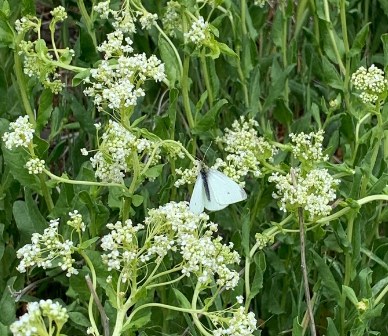 Cabbage white, Pieris rapae: Look for these small (<2”) butterflies in gardens, around town, or just about everywhere! Cabbage whites are white with black tips on their forewings. You’ll notice female Cabbage whites have two black spots while males only have one. These butterflies are extremely common, and can even be found on roadsides and near dandelion patches.
Cabbage white, Pieris rapae: Look for these small (<2”) butterflies in gardens, around town, or just about everywhere! Cabbage whites are white with black tips on their forewings. You’ll notice female Cabbage whites have two black spots while males only have one. These butterflies are extremely common, and can even be found on roadsides and near dandelion patches.
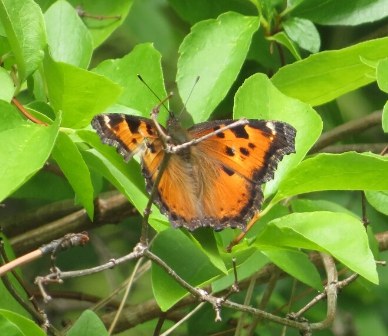 California tortoiseshell, Nymphalis californica: Look for this medium sized (< 2.5”) butterfly on sunny days in Central Oregon. With their wings spread they are bright orange and may be confused for monarch butterflies. You’re likely to find them on local trails where they frequently “puddle” sipping salts and minerals from damp soil. Watch out for when they gather in huge swarms near the mountains during the summer!
California tortoiseshell, Nymphalis californica: Look for this medium sized (< 2.5”) butterfly on sunny days in Central Oregon. With their wings spread they are bright orange and may be confused for monarch butterflies. You’re likely to find them on local trails where they frequently “puddle” sipping salts and minerals from damp soil. Watch out for when they gather in huge swarms near the mountains during the summer! 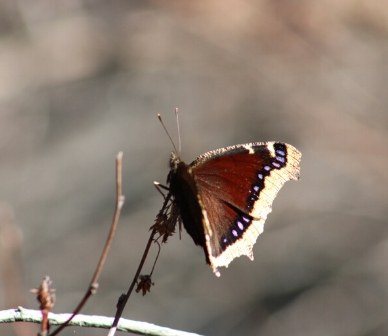 Mourning cloak, Nymphalis antiopa: These larger (>3”) butterflies are some of the first to emerge from winter dormancy in the spring. Mourning cloaks are a velvety chocolate color, with iridescent blue spots along a bright yellow margin. They overwinter as adult butterflies, emerge in the spring to lay a new batch of eggs, and then the caterpillars grow throughout the summer months. In the fall, you’ll see a fresh batch of adults taking flight and enjoying the final days of warmth before finding cover for their winter hibernation.
Mourning cloak, Nymphalis antiopa: These larger (>3”) butterflies are some of the first to emerge from winter dormancy in the spring. Mourning cloaks are a velvety chocolate color, with iridescent blue spots along a bright yellow margin. They overwinter as adult butterflies, emerge in the spring to lay a new batch of eggs, and then the caterpillars grow throughout the summer months. In the fall, you’ll see a fresh batch of adults taking flight and enjoying the final days of warmth before finding cover for their winter hibernation. 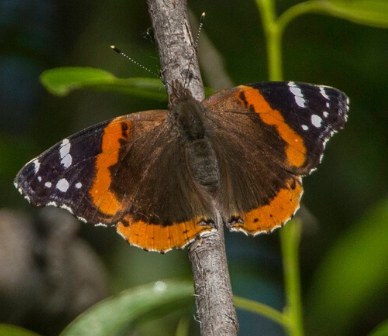 Red admiral, Vanessa atalanta: If you see a flash of red in the sky, it might be one of these medium sized (< 2.5”) butterflies. Red admirals have an erratic flight path, but you can identify them easily by the red bands on their hind and forewings. You can find red admirals just about anywhere. Red admiral caterpillars are especially cool since they will wrap themselves up in a nest of leaves and silk while they eat and grow! They are very common throughout Central Oregon and can often be enticed to land on an arm or shoulder if you patiently sit still in their vicinity.
Red admiral, Vanessa atalanta: If you see a flash of red in the sky, it might be one of these medium sized (< 2.5”) butterflies. Red admirals have an erratic flight path, but you can identify them easily by the red bands on their hind and forewings. You can find red admirals just about anywhere. Red admiral caterpillars are especially cool since they will wrap themselves up in a nest of leaves and silk while they eat and grow! They are very common throughout Central Oregon and can often be enticed to land on an arm or shoulder if you patiently sit still in their vicinity.
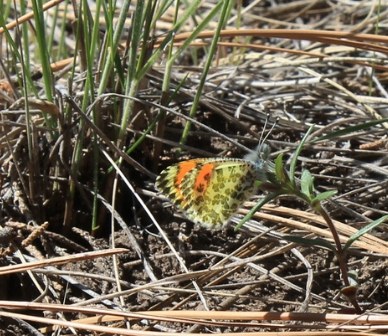 Sara’s orangetip, Anthocharis sara: This small (< 1.5”) butterfly is easy to identify by its bright-orange tips! The females are yellowish, the males bright white. Both male and female butterflies will have the orange tipped wings, but you might notice that male orange spots are larger. Look for these butterflies in the early spring near fields, meadows, and canyons.
Sara’s orangetip, Anthocharis sara: This small (< 1.5”) butterfly is easy to identify by its bright-orange tips! The females are yellowish, the males bright white. Both male and female butterflies will have the orange tipped wings, but you might notice that male orange spots are larger. Look for these butterflies in the early spring near fields, meadows, and canyons.
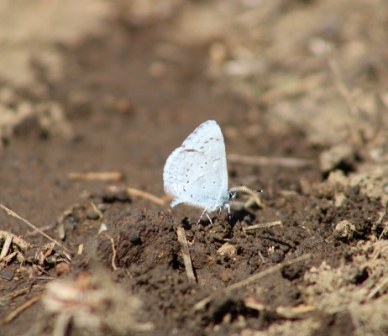 Echo azure, Celastrina echo: You can find these small (< 1.25”) butterflies throughout Central Oregon. Spring azures are a chalky, pale grey-blue with black spots on the underwing, but most folks notice the flash of dazzling, vivid blue on the top side of the wings. Look for them flitting about the edges of woods, in open fields, near wetlands or even in cities. These are often the first blues we’ll see each year!
Echo azure, Celastrina echo: You can find these small (< 1.25”) butterflies throughout Central Oregon. Spring azures are a chalky, pale grey-blue with black spots on the underwing, but most folks notice the flash of dazzling, vivid blue on the top side of the wings. Look for them flitting about the edges of woods, in open fields, near wetlands or even in cities. These are often the first blues we’ll see each year!
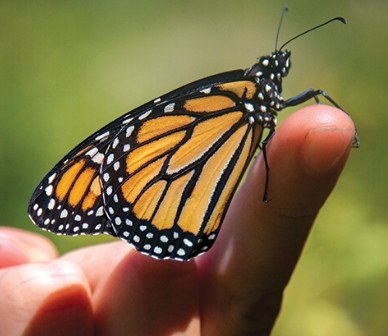 Monarch, Danaus plexippus: Though they may not be common in Central Oregon, no butterfly list would be complete without Monarchs. These larger (<3.5”) butterflies are known for their beautiful orange and black pattern, their incredible migration, and sadly, their devastating decline. Central Oregon is in the migration pathway of western monarchs and served as a historical breeding ground for these butterflies.
Monarch, Danaus plexippus: Though they may not be common in Central Oregon, no butterfly list would be complete without Monarchs. These larger (<3.5”) butterflies are known for their beautiful orange and black pattern, their incredible migration, and sadly, their devastating decline. Central Oregon is in the migration pathway of western monarchs and served as a historical breeding ground for these butterflies.
Today, the Deschutes Land Trust is working to improve monarch butterfly habitat by planting milkweed and promoting native pollinator plant growth on our Preserves and in our community! Learn how you can help here.
Learn more:
- Five Butterflies That are Not Monarchs
- What are all those orange butterflies?
- Tips for an Excellent Butterfly Expedition
- Join us for a guided butterfly walk!


